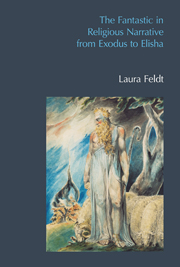Book contents
- Frontmatter
- Contents
- Acknowledgements
- Introduction: More Things—Marvels, Monsters, Miracles
- 1 Fields of Fantasy
- 2 Fantasy and Religious Narrative: Theory and Strategy
- 3 Marvels, Magic and Mystery: Reading the Fantastic in the Exodus Narrative
- 4 Between Wonder and Doubt: Fantastic Strategies, Their Effects and Status in the Exodus Narrative
- 5 Exodus as Mnemo-Fantasy: The Functions of the Fantastic in the Exodus Narrative
- 6 From Ethnogenesis to Everyday Life: Contextualizing the Fantastic in Hebrew Bible Narrative
- 7 Es spukt…—The Fantastic in Religious Narrative
- Bibliography
- Index of Biblical References
- Index of Authors
7 - Es spukt…—The Fantastic in Religious Narrative
- Frontmatter
- Contents
- Acknowledgements
- Introduction: More Things—Marvels, Monsters, Miracles
- 1 Fields of Fantasy
- 2 Fantasy and Religious Narrative: Theory and Strategy
- 3 Marvels, Magic and Mystery: Reading the Fantastic in the Exodus Narrative
- 4 Between Wonder and Doubt: Fantastic Strategies, Their Effects and Status in the Exodus Narrative
- 5 Exodus as Mnemo-Fantasy: The Functions of the Fantastic in the Exodus Narrative
- 6 From Ethnogenesis to Everyday Life: Contextualizing the Fantastic in Hebrew Bible Narrative
- 7 Es spukt…—The Fantastic in Religious Narrative
- Bibliography
- Index of Biblical References
- Index of Authors
Summary
The phrase of the header above recalls Rudolph Otto's phrase ‘es spukt hier’ (Otto 1936: 154) and his talk of vague intimations of a numinous ‘something’ as well as Freud when he clarifies the uncanny by speaking of ‘ein unheimliches Haus’ as ‘ein Haus, in dem es spukt’ (1970: 264). I use it here to point to the spectres, the haunting and the fascination that is peculiar to the fantastic in religious narrative. In this chapter, I address the question of what fantasy theory can contribute to the study of religious narrative. I do this by first engaging the question of the contribution of the fantasy-theoretical perspective to the understanding of the Hebrew Bible narratives and then by discussing ideas about what a religious narrative is and does in the study of religion.
The Fantastic in Hebrew Bible Religious Narrative
Contrary to key views in the exegetical tradition, I have argued that the fantastic elements (miracles, plagues, narratives of magic, visions) should not be marginalized as entertaining embellishment, inauthentic additions or borrowings, that their impact should not be diminished by a reduction of their number or their distribution to different background traditions, and further that they cannot be interpreted solely as vehicles for praise of the deity's saving acts, working only to found and orient their recipients and elicit belief. Overall, I have tried to take into account not only what these narratives communicate but also how, and what this means for the process of reception.
- Type
- Chapter
- Information
- The Fantastic in Religious Narrative from Exodus to Elisha , pp. 235 - 258Publisher: Acumen PublishingPrint publication year: 2012



